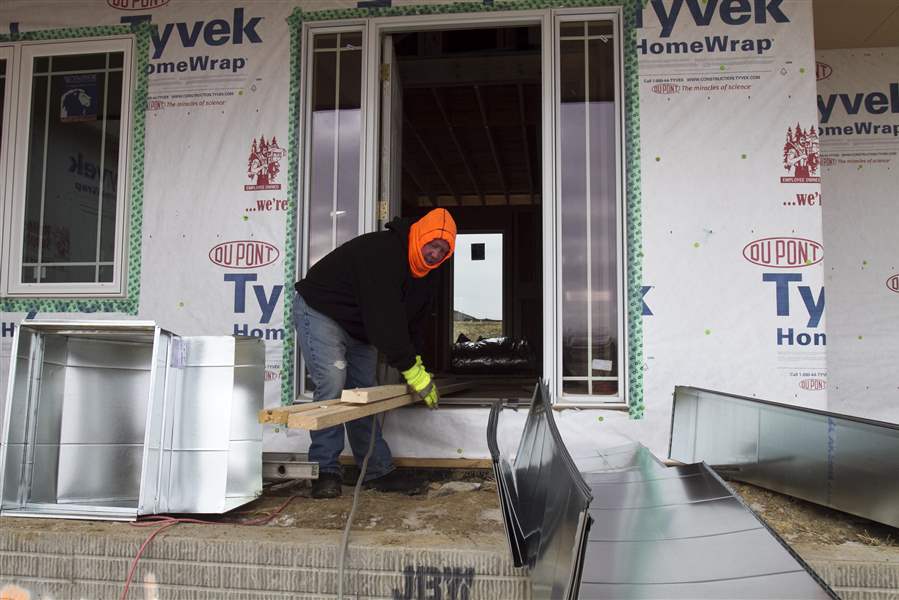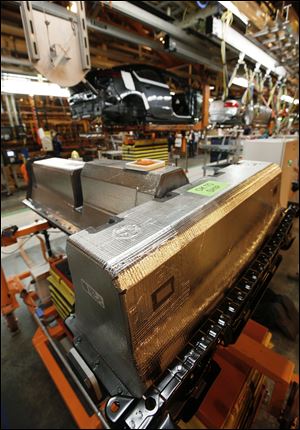
Factory output grows, shoppers fill malls, yet housing still drags
12/16/2010
A contractor carries heating ducts to a house under construction in Gretna, Neb. While the overall economic recovery looks durable, the housing index still indicates consumer pessimism.
Nati Harnik / AP

A contractor carries heating ducts to a house under construction in Gretna, Neb. While the overall economic recovery looks durable, the housing index still indicates consumer pessimism.
WASHINGTON -- The economy appears to be settling into a period of moderate but enduring growth.
Factories are producing more goods, retail prices are low, and the malls are full ahead of the holidays.
Still, the housing market is a ma-jor drag on the economic recovery. Builders, who are competing with millions of foreclosed properties, are pessimistic about their prospects the next six months.
The latest government and private-sector reports support a more optimistic but measured view that the economy is growing at a faster rate, and that 2011 will be better than most economists thought just months ago.
"This is all consistent with an economy that is getting back on track and developing momentum going into next year," Carl Riccadonna, a Deutsche Bank economist, said.
Manufacturers have been a major reason for the momentum.
Factory output grew 0.3 percent in November, the fifth-straight month of gains, the Federal Reserve said. Production of computers, industrial equipment, appliances, and electronic goods all rose. That's evidence that firms and consumers are spending more, economists said.
Factory output has recovered by 10.6 percent since its low point in June, 2009, according to Steven Wood, chief economist with Insight Economics LLC. However, it's still at 9.1 percent.

A battery pack is ready for installation in a Chevy Volt at a GM plant in Hamtramck, Mich. Factory output grew in November.
Mr. Riccadonna noted businesses will get a tax break for buying new equipment next year, under the tax agreement negotiated between President Obama and congressional Republicans. That measure passed the Senate Wednesday and is headed to the House. If approved, that could spur further business investment, Mr. Riccadonna said.
Consumers also would benefit, and many are increasing their spending. Retail sales rose in November, the fifth-straight monthly gain. That's a sign the holiday shopping season will be a healthy one.
One reason for that is tame inflation. Consumer prices barely changed in November, the Labor Department said Wednesday.
Small increases in food and energy costs pushed the Consumer Price Index up 0.1 percent.
Excluding food and energy costs, core consumer prices rose 0.1 percent, the first increase in four months. In the past year, the core index rose 0.8 percent. That's slightly higher than October's 0.6 percent annual increase, which was the lowest since the index began in 1957.
Prices have stabilized since the summer, when the index dropped for three straight months. That raised fears of deflation, a prolonged and debilitating drop in prices and wages, and the value of stocks, homes, and other assets. But since then, the index has risen for five straight months.
Food prices rose slightly last month, mostly because of to higher costs for meats, eggs and fish. Cereals, baked goods and nonalcoholic beverages also rose substantially.
Gas prices increased 0.7 percent, driving energy costs up for the fifth straight month.
Most Americans won't feel much better about the economy until they see more jobs and the 9.8 percent unemployment rate begins to fall.
Many economists expect at least some increase in hiring during the months ahead. That would reverse a disappointing showing in November, when employers added a net total of only 39,000 jobs.
"This industrial recovery has gone on long enough that we should see more hiring going forward," Joel Naroff, president of Naroff Economic Advisors, said.
Home builders don't share the optimism, however. The National Association of Home Builders said its monthly reading of builders' sentiment remained unchanged in December at 16.
While that's the highest reading since June, any reading below 50 indicates negative sentiment about the market. The index hasn't been above that point since April, 2006.
Builders are anticipating fewer sales in December than most years, NAHB Chairman Bob Jones said. That's mostly because of competition from sharply discounted foreclosed homes, tighter lending standards, and poor overall job growth. December is traditionally one of the slowest times for sales.